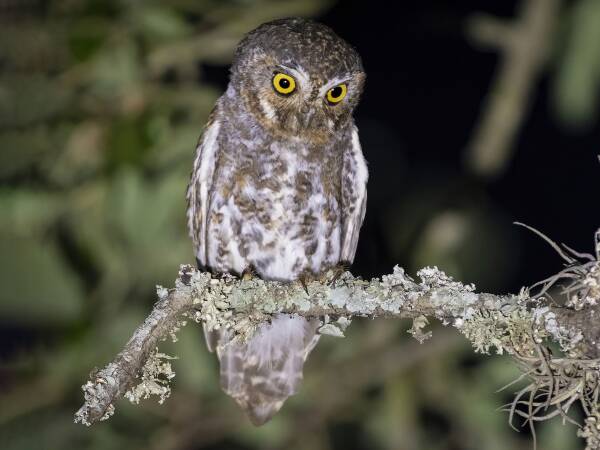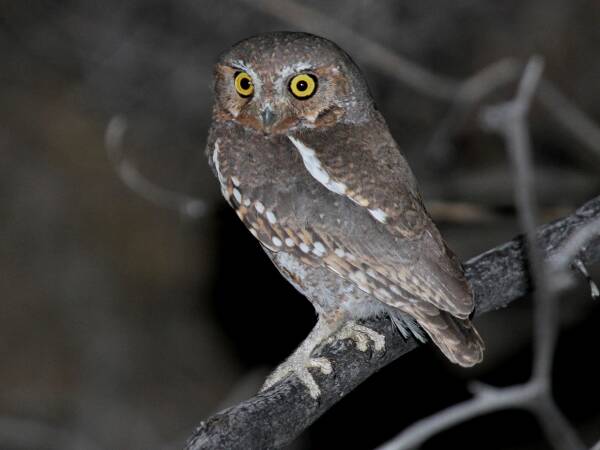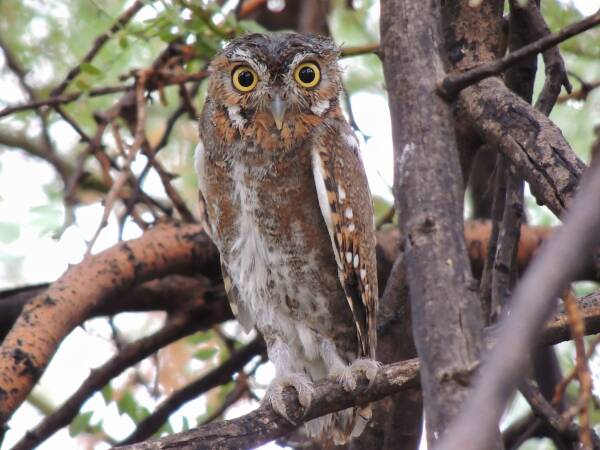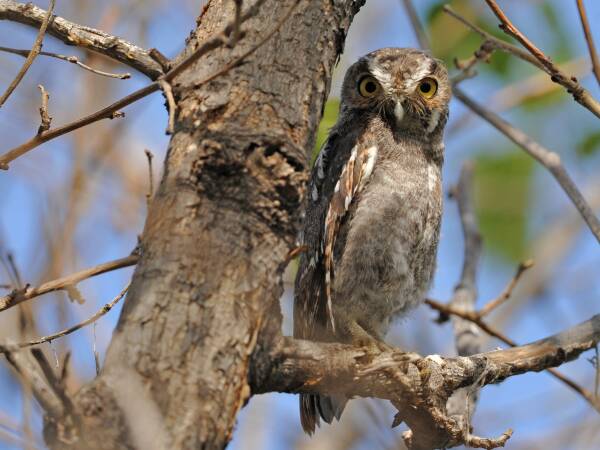The Elf Owl (Micrathene Whitneyi) is the lightest owl in the world, although the Whiskered Owl and Tamaulipas Pygmy Owl are similarly smaller in length. It is also the smallest owl in the world. The little owl is about 12-14 centimeters long (the size of a Coke can) and weighs between 35-55 grams. Their main protrusions (the flight feathers) extend almost beyond their tails. Its legs are quite long and often appear bow-legged. It has pale yellow eyes, thin white "eyebrows" and a gray beak with a tapered tip. Elf owls often roost in woodpecker holes on cactus. It also builds nests in natural tree cavities. It is nocturnal and feeds mainly on insects.

They are small, compact birds with yellow eyes, short tails, no ear hairs, and larger than average heads.
Elf owls prefer to nest in ancient woodpecker holes and similar cavities in trees and cacti.
Its food includes insects such as crickets, beetles, moths, grasshoppers, cicadas, stick insects, wasps, spiders, small lizards, rodents and scorpions. Not bad for a little raptor.
Like most bird species, males attract females at the beginning of the breeding season by marking their territory with a demonstrative song. He sings and feeds the female inside the nest to show what a great father he will be.

Once paired, elf owls nest together for survival, mobbing any potential predators such as snakes, mammals, and larger owls. They produce one litter each breeding season.
Elf owls are known for their unique way of doing housework: they capture a thread snake (Lepidoptera serrata) and bring it back to the nest so that it can eat parasites that might harm its chicks. Tree ants are also welcomed into the nest to perform the same tasks.
When an elf owl captures a stinging creature such as a scorpion or wasp, it uses its beak to manipulate the prey, removing unwanted body parts such as stings or wings, and neutralizing it before passing the prey to its chicks.

Elf owls are also the world's smallest birds of prey.
Elf owls are known to migrate in large flocks, with migration patterns varying depending on the group and habitat location.
Elf owls will feign death when being held, an adaptation that encourages predators to relax their grip so the owl can escape.
Elf owls are also notoriously territorial. Territories are established by males and defended by both males and females, and males also tend to view their chosen female mate as territory that needs to be defended. This defense is usually accomplished through song. During the breeding season, elf owls are monogamous and breed in pairs, but may appear in small groups when migrating and mobbing predators. Both adults and young birds may be preyed upon by other predatory birds such as jays, hawks, and owls.

Elf owls have a lifespan of 3 to 6 years; in captivity, they can live up to 10 years. The most common types of mortality for these owls are predation, exposure, and inter- and intra-species competition.
Hunting takes place mainly at night. To do this, they usually fly in a straight line, but they use arcing flights when near their nests and when traveling to and from roosts. Like some birds, they live among cacti, taking advantage of the shade and climate they provide.
Elf Owl populations have continued to decline in recent years due to continued loss of native habitat, particularly in California's desert regions. To date, elf owls are not considered globally endangered, but since there are fewer than 150,000 owls in the United States, they are listed as "endangered" in California. California has implemented a captive breeding program in an attempt to increase that number, while many environmental and government agencies work to protect their riverbank and desert homes.
animal tags: nighthawk
We created this article in conjunction with AI technology, then made sure it was fact-checked and edited by a Animals Top editor.